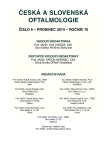Corneal Transplantations in the Czech Republic in 2012
Authors:
P. Studený; J. Hamouz; P. Kuchynka
Authors‘ workplace:
Oční klinika FNKV a 3. LF UK Praha, přednosta prof. MUDr. Pavel Kuchynka, CSc.
Published in:
Čes. a slov. Oftal., 70, 2014, No. 6, p. 224-227
Category:
Original Article
Overview
Objective:
To determine the frequency of corneal transplantations in the Czech Republic in 2012, the percentage representations of the different types of surgeries and main indications for corneal transplantation.
Methodology:
All clinics performing the corneal transplantations were asked to complete a questionnaire about the number of corneal transplants, types of surgeries and indications for such procedures. The obtained data were compared with the annual report of corneal banks for the year 2012.
Results:
Data for 465 transplantations were analyzed, it represents 92, 8 % of all corneas issued by the corneal tissue banks. The most common indication for corneal transplantation (regardless of type) was bullous keratopathy (40 % of cases), then keratoconus and other ectatic diseases (19,1 %) and endothelial dystrophy (16,1 %). The most common type of translation was penetrating keratoplasty (50,75 %), then posterior lamellar keratoplasty (44, 95 %) and anterior lamellar keratoplasty (4,3 %).
Conclusion:
Acquired data confirm increasing proportion of lamellar transplantations among all corneal keratoplasties, especially posterior lamellar keratoplasty. This approach probably affects indications, for which keratoplasties are made. Keratoplasties are indicated significantly due to endothelial corneal dystrophies such as bullous keratopathy and other endothelial dystrophies. Keratoconus represents approximately 20 % of indications to corneal transplantation.
Key words:
corneal transplantation, penetrating keratoplasty, lamellar keratoplasty
Sources
1. Coster, DJ., Lowe, MT., Keane, MC. et al.: A comparison of Lamellar and Penetrating Keratoplasty Outcomes: A Registry Study. Ophthalmology, 2014.
2. Cunningham, WJ., Brookes, NH., Twohill, HC. et al.: Trends in the distribution of donor corneal tissue and indications for corneal transplantation the New Zealand National Eye Bank Study 2000-2009. Clin Exp Ophthalmol, 2012; 40: 141–7.
3. Galvis, V., Tello, A., Gomez, AJ. et al.: Corneal Transplantation at an Ophthalmological Referral Center in Colombia: Indications and Techniques (2004-2011). Open Ophthalmol J, 2013; 17,7: 30–33.
4. Keenan, TD., Jones, MN., Rushton, S. et al.: National Health Service blood and transplant ocular tissue advisory group and contributing ophthalmologists (ocular tissue advisory group audit study 8).Trends in the indications for corneal graft surgery in the United Kingdom. 1999 through 2009. Arch Ophthalmol, 2012; 130: 621–8.
5. Koordinační středisko transplantací. Výroční zprávy. Přehled činnosti tkáňových bank 2007. [cit. 2014-05.05]. Dostupné z https://www.kst.cz/web/download/prehle-cinnosti-tkanovych-bank-2007.pdf.
6. Koordinační středisko transplantací. Výroční zprávy. Přehled činnosti tkáňových bank 2008. [cit. 2014-05.05]. Dostupné z https://www.kst.cz/web/download/prehle-cinnosti-tkanovych-bank-2008.pdf.
7. Koordinační středisko transplantací. Výroční zprávy. Přehled činnosti tkáňových bank 2009. [cit. 2014-05.05]. Dostupné z https://www.kst.cz/web/download/prehle-cinnosti-tkanovych-bank-2009.pdf.
8. Koordinační středisko transplantací. Výroční zprávy. Přehled činnosti tkáňových bank 2010. [cit. 2014-05.05]. Dostupné z https://www.kst.cz/web/download/prehle-cinnosti-tkanovych-bank-2010.pdf.
9. Koordinační středisko transplantací. Výroční zprávy. Přehled činnosti tkáňových bank 2011. [cit. 2014-05.05]. Dostupné z https://www.kst.cz/web/download/prehle-cinnosti-tkanovych-bank-2011.pdf.
10. Koordinační středisko transplantací. Výroční zprávy. Přehled činnosti tkáňových bank 2012. [cit. 2014-05.05]. Dostupné z https://www.kst.cz/web/download/prehle-cinnosti-tkanovych-bank-2012.pdf.
11. Módis, L.,Jr., Szalai, E., Facskó, A. et al.: Corneal transplantation in Hungary (1946-2009). Clin Exp Ophthalmol, 2011; 39: 520–5.
12. Sheldon, CA., McCarthy, JM., White, VA.: Correlation of clinical and pathologic diagnoses of corneal disease in penetrating keratoplasties in Vancouver a 10-year review. Can J Ophthalmol, 2012; 47: 5–10.
13. Ting, DS., Sau, CY., Srinivasan, S.et al.: Changing trends in keratoplasty in the West of Scotland: a 10-year review. Br J Ophthalmol, 2012; 96: 405–8.
14. Wang, J., Hasenfus, A., Schirra, F. et al.: Changing indications for penetrating keratoplasty in Homburg/Saar from 2001 to 2010 – histopathology of 1.200 corneal buttons. Graefes Arch Clin Exp Ophthalmol, 2013; 251(3): 797–802.
15. Williams, KA., Lowe, MT., Keane, MC. et al.: The Australian Corneal Graft Registry: 2012 Report. Adelaide, Australia: Snap Printing, 2012; vol. 182: 85–6.
16. Xie, L., Qi, F., Gao, H. et al.: Major shifts in corneal transplantation procedures in north China.5316 eyes over 12 years. Br J Ophthalmol, 2009;93:1291–5.
17. Zare, M., Javadi, MA., Einollahi, B. et al.: Changing indications and surgical techniques for corneal transplantation between 2004, and 2009 at a tertiary referral center. Middle East Afr J Ophthalmol, 2012; 19: 323–9.
18. Zirm, EK.: Eine erfolgreiche totale Keratoplastik (A successful total keratoplasty). 1906. Refract Corneal Surg, 1989; 5(4): 258-61.
Labels
OphthalmologyArticle was published in
Czech and Slovak Ophthalmology

2014 Issue 6
Most read in this issue
- Orbital Complications of Sinusitis
- Actual State of the One Day Simultaneous Bilateral Cataract Surgery Issue
- Diagnostic Pitfalls of Pseudo-Foster Kennedy Syndrome – A Case Report
- The Molecular Genetic and Clinical Findings in two Probands with Stargardt Disease
